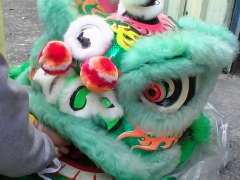











| Introduction of the Sijhou lion dance team | ||||||
| Many elementary schools in Sijhou Township promote the lion dance activity, with many lion dance teams. The most representative are the Guangdong lions of Cheng-gong Elementary School, the Hakka lions of Cheng-gong Elementary School Xipan Branch, and the Taiwan southern lions at our school. We will introduce them in the following. | ||||||
Changhua County Sijhou Township Cheng-gong Elementary School is the first school to promote lion dance in Sijhou Township, and they also have a famous lion dance team. The lion dance team at Cheng-gong Elementary School was established in 1992. At the beginning, local martial arts masters went to the school to promote Taiwan southern lion dance, later since it became part of a curriculum and incorporated into sports education, it attempted to promote other types of lion dance. At the current time it primarily promotes the Guangdong lion dance. Guangdong lions are fluffy and cute. Guangdong lions have a special horn on the top of their heads, and this is unique compared to Taiwan southern lions and Hakka lions. The eyelids and ears of Guangdong lions can be controlled by ropes, so that lions can blink and move their ears, as if saying to us “Come! Come!” The performance of Guangdong lions focuses on the lightness of feet, rapidly jumping up and down. So in practice, other than the movement and controls of the hands, feet movement is very important. The Cheng-gong Elementary School lion dance team is frequently invited to perform in different places. In the 1993 Taiwan Sports Games, it was appointed to welcome the Game Torch on behalf of Changhua County; in April 1993, Southern Changhua Community TV Station came to school to record the lion dance, broadcasting it in “Reports on Local Customs”; on May 6, the team participated in Changhua County traditional customs and arts education performance. |
||||||
|
||||||
Ancestors of students in Changhua County Sijhou Township Cheng-gong Elementary School Xipan Branch were generally Hakka people who moved from Taoyuan, Hsinchu, and Miaoli during the period of Japanese colonial rule. Due to the factors of temporal and spatial backgrounds, much of early Hakka culture has disappeared. Thus, Council for Hakka Affairs, Executive Yuan and Changhua County Government established “Changhua County Hakka Traditional Culture and Living Learning Center” at Xipan Branch. In order to revitalize the past glamour of the local Hakka communities, in 2006 the school established a lion dance team, which primarily guides students in martial arts and Hakka lion dance. Because the Hakka lions have large mouths that open and close, they are also referred to as open-mouth lions. Other than open-mouth lions, they are also called box lions, because after their mouths open, they look like square boxes. Other than lion heads, they also have lion monks. The main job of lion monks is to play with the lions and to guide the path of lions, and they are frequently the clowns and key figures in lion dances. After years of training and promotions, Xipan Branch Lion Dance Troupe has been invited to various cities and counties in central Taiwan for performances. It has also won second place at the 2010 National Education Heritage for Hakka Open-Mouth Lion Folk Sport Games. |
||||||
|
||||||
In the 2009 academic year, this school established the Zunliao Lion Dance Club, connecting with Puhsuan Temple to pass on the folk traditions, and seeking to cultivate local culture to promote school and community development. A volunteer lion dance coach is invited to come to the school to guide all the students in the school on Monday and Thursday mornings. The students begin by learning boxing then lion dance art. Even though it has only been two short years, but with the full support from Puhsuan Temple, the diligent instruction of the voluntary coaches, and the hardworking students at learning, they were able to perform at occasions such as the township mayor coming into office, school celebrations, and community sports events, as well as related community events. This fully shows the spirit of perseverance of Zunliao. The biggest difference between Taiwan southern lion dance and Hakka lion dance or Guangdong lion dance is in the lion’s mouths and appearances. The mouths of Taiwanese southern lions are closed and cannot open, so Taiwan southern lions are also known as closed-mouth lions. Taiwan southern lions seem more fierce compared to other lions, and they have the trigram figures on their heads, so they are also known as trigram lions. |
||||||
|
||||||















